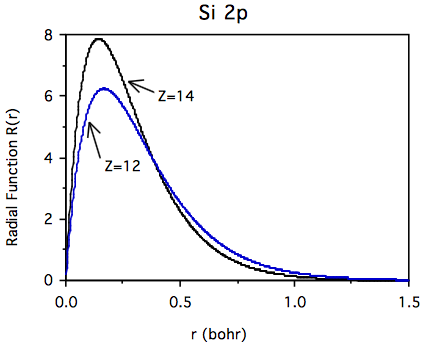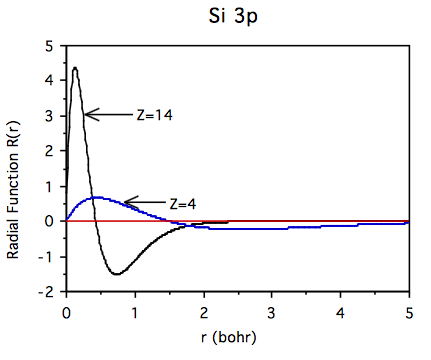22.2.4: iv. Review Exercises Solutions
- Page ID
- 79441
\( \newcommand{\vecs}[1]{\overset { \scriptstyle \rightharpoonup} {\mathbf{#1}} } \)
\( \newcommand{\vecd}[1]{\overset{-\!-\!\rightharpoonup}{\vphantom{a}\smash {#1}}} \)
\( \newcommand{\id}{\mathrm{id}}\) \( \newcommand{\Span}{\mathrm{span}}\)
( \newcommand{\kernel}{\mathrm{null}\,}\) \( \newcommand{\range}{\mathrm{range}\,}\)
\( \newcommand{\RealPart}{\mathrm{Re}}\) \( \newcommand{\ImaginaryPart}{\mathrm{Im}}\)
\( \newcommand{\Argument}{\mathrm{Arg}}\) \( \newcommand{\norm}[1]{\| #1 \|}\)
\( \newcommand{\inner}[2]{\langle #1, #2 \rangle}\)
\( \newcommand{\Span}{\mathrm{span}}\)
\( \newcommand{\id}{\mathrm{id}}\)
\( \newcommand{\Span}{\mathrm{span}}\)
\( \newcommand{\kernel}{\mathrm{null}\,}\)
\( \newcommand{\range}{\mathrm{range}\,}\)
\( \newcommand{\RealPart}{\mathrm{Re}}\)
\( \newcommand{\ImaginaryPart}{\mathrm{Im}}\)
\( \newcommand{\Argument}{\mathrm{Arg}}\)
\( \newcommand{\norm}[1]{\| #1 \|}\)
\( \newcommand{\inner}[2]{\langle #1, #2 \rangle}\)
\( \newcommand{\Span}{\mathrm{span}}\) \( \newcommand{\AA}{\unicode[.8,0]{x212B}}\)
\( \newcommand{\vectorA}[1]{\vec{#1}} % arrow\)
\( \newcommand{\vectorAt}[1]{\vec{\text{#1}}} % arrow\)
\( \newcommand{\vectorB}[1]{\overset { \scriptstyle \rightharpoonup} {\mathbf{#1}} } \)
\( \newcommand{\vectorC}[1]{\textbf{#1}} \)
\( \newcommand{\vectorD}[1]{\overrightarrow{#1}} \)
\( \newcommand{\vectorDt}[1]{\overrightarrow{\text{#1}}} \)
\( \newcommand{\vectE}[1]{\overset{-\!-\!\rightharpoonup}{\vphantom{a}\smash{\mathbf {#1}}}} \)
\( \newcommand{\vecs}[1]{\overset { \scriptstyle \rightharpoonup} {\mathbf{#1}} } \)
\( \newcommand{\vecd}[1]{\overset{-\!-\!\rightharpoonup}{\vphantom{a}\smash {#1}}} \)
\(\newcommand{\avec}{\mathbf a}\) \(\newcommand{\bvec}{\mathbf b}\) \(\newcommand{\cvec}{\mathbf c}\) \(\newcommand{\dvec}{\mathbf d}\) \(\newcommand{\dtil}{\widetilde{\mathbf d}}\) \(\newcommand{\evec}{\mathbf e}\) \(\newcommand{\fvec}{\mathbf f}\) \(\newcommand{\nvec}{\mathbf n}\) \(\newcommand{\pvec}{\mathbf p}\) \(\newcommand{\qvec}{\mathbf q}\) \(\newcommand{\svec}{\mathbf s}\) \(\newcommand{\tvec}{\mathbf t}\) \(\newcommand{\uvec}{\mathbf u}\) \(\newcommand{\vvec}{\mathbf v}\) \(\newcommand{\wvec}{\mathbf w}\) \(\newcommand{\xvec}{\mathbf x}\) \(\newcommand{\yvec}{\mathbf y}\) \(\newcommand{\zvec}{\mathbf z}\) \(\newcommand{\rvec}{\mathbf r}\) \(\newcommand{\mvec}{\mathbf m}\) \(\newcommand{\zerovec}{\mathbf 0}\) \(\newcommand{\onevec}{\mathbf 1}\) \(\newcommand{\real}{\mathbb R}\) \(\newcommand{\twovec}[2]{\left[\begin{array}{r}#1 \\ #2 \end{array}\right]}\) \(\newcommand{\ctwovec}[2]{\left[\begin{array}{c}#1 \\ #2 \end{array}\right]}\) \(\newcommand{\threevec}[3]{\left[\begin{array}{r}#1 \\ #2 \\ #3 \end{array}\right]}\) \(\newcommand{\cthreevec}[3]{\left[\begin{array}{c}#1 \\ #2 \\ #3 \end{array}\right]}\) \(\newcommand{\fourvec}[4]{\left[\begin{array}{r}#1 \\ #2 \\ #3 \\ #4 \end{array}\right]}\) \(\newcommand{\cfourvec}[4]{\left[\begin{array}{c}#1 \\ #2 \\ #3 \\ #4 \end{array}\right]}\) \(\newcommand{\fivevec}[5]{\left[\begin{array}{r}#1 \\ #2 \\ #3 \\ #4 \\ #5 \\ \end{array}\right]}\) \(\newcommand{\cfivevec}[5]{\left[\begin{array}{c}#1 \\ #2 \\ #3 \\ #4 \\ #5 \\ \end{array}\right]}\) \(\newcommand{\mattwo}[4]{\left[\begin{array}{rr}#1 \amp #2 \\ #3 \amp #4 \\ \end{array}\right]}\) \(\newcommand{\laspan}[1]{\text{Span}\{#1\}}\) \(\newcommand{\bcal}{\cal B}\) \(\newcommand{\ccal}{\cal C}\) \(\newcommand{\scal}{\cal S}\) \(\newcommand{\wcal}{\cal W}\) \(\newcommand{\ecal}{\cal E}\) \(\newcommand{\coords}[2]{\left\{#1\right\}_{#2}}\) \(\newcommand{\gray}[1]{\color{gray}{#1}}\) \(\newcommand{\lgray}[1]{\color{lightgray}{#1}}\) \(\newcommand{\rank}{\operatorname{rank}}\) \(\newcommand{\row}{\text{Row}}\) \(\newcommand{\col}{\text{Col}}\) \(\renewcommand{\row}{\text{Row}}\) \(\newcommand{\nul}{\text{Nul}}\) \(\newcommand{\var}{\text{Var}}\) \(\newcommand{\corr}{\text{corr}}\) \(\newcommand{\len}[1]{\left|#1\right|}\) \(\newcommand{\bbar}{\overline{\bvec}}\) \(\newcommand{\bhat}{\widehat{\bvec}}\) \(\newcommand{\bperp}{\bvec^\perp}\) \(\newcommand{\xhat}{\widehat{\xvec}}\) \(\newcommand{\vhat}{\widehat{\vvec}}\) \(\newcommand{\uhat}{\widehat{\uvec}}\) \(\newcommand{\what}{\widehat{\wvec}}\) \(\newcommand{\Sighat}{\widehat{\Sigma}}\) \(\newcommand{\lt}{<}\) \(\newcommand{\gt}{>}\) \(\newcommand{\amp}{&}\) \(\definecolor{fillinmathshade}{gray}{0.9}\)
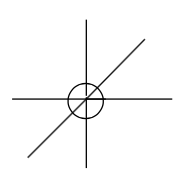
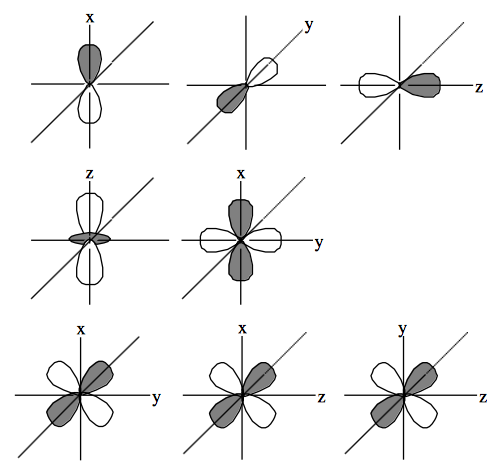
- i. In ammonia the only "core" orbital is the N 1s and this becomes an a1 orbital in \(C_{3v}\) symmetry. The N 2s orbitals and 3 H 1s orbitals become 2 \(a_1\) and an e set of orbitals. The remaining N 2p orbitals also become 1 \(a_1\) and a set of e orbitals. The total valence orbitals in \(C_{3v}\) symmetry are \(3a_1\) and 2e orbitals.
ii. In water the only core orbital is the O 1s and this becomes an a1 orbital in \(C_{2v}\) symmetry. Placing the molecule in the yz plane allows us to further analyze the remaining valence orbitals as: O \(2p_z = a_1\), O \(2p_y\text{ as } b_2\text{ , and O } 2p_x\text{ as } b_1\). The H 1s + H 1s combination is an \(a_1\) whereas the H 1s - H 1s combination is a \(b_2\).
iii. Placing the oxygens of \(H_2O_2\) in the yz plane (z bisecting the oxygens) and the (cis) hydrogens distorted slightly in +x and -x directions allows us to analyze the orbitals as follows. The core O 1s + O 1s combination is an a orbital whereas the O 1s - O 1s combination is aborbital. The valence orbitals are: O2s+O2s=a, O2s-O2s=b, O \(2p_x\text{ + O }2p_x\) = b, O 2px - O 2px = a, O 2py + O 2py = a, O 2py - O 2py = b, O 2pz + O 2pz = b, O 2pz - O 2pz = a, H 1s + H 1s = a, and finally the H 1s - H 1s = b.
iv. For the next two problems we will use the convention of choosing the z axis as principal axis for the \(D_{\infty h}\text{, }D_{2h}\text{, and } C_{2v}\) point groups and the xy plane as the horizontal reflection plane in \(C_s\) symmetry.
\begin{align} & & D_{\infty h} & & D_{2h} & & C_{2v} & & C_s & \\ & N 1s & & \sigma_g & & a_g & & a_1 & & a^{\prime} & \\ & N 2s & & \sigma_g & & a_g & & a_1 & & a^{\prime} & \\ & N 2p_x & & \pi_{xu} & & b_{3u} & & b_1 & & a^{\prime} & \\ & N 2p_y & & \pi_{yu} & & b_{2u} & & b_2 & & a^{\prime} & \\ & N 2p_z & & \sigma_{u} & & b_{1u} & & a_1 & & a^{\prime\prime} & \end{align}
v. The Nitrogen molecule is in the yz plane for all point groups except the Cs in which case it is placed in the xy plane.
\begin{align} & & D_{\infty h} & & D_{2h} & & C_{2v} & & C_s & \\ & N 1s + N 1s & & \sigma_g & & a_g & & a_1 & & a^{\prime} & \\ & N 1s - N 1s & & \sigma_u & & b_{1u} & & b_2 & & a^{\prime} & \\ & N 2s + N 2s & & \sigma_g & & a_g & & a_1 & & a^{\prime} & \\ & N 2s - N 2s & & \sigma_u & & b_{1u} & & b_2 & & a^{\prime} & \\ & N 2p_x + N 2p_x & & \pi_{xu} & & b_{3u} & & b_1 & & a^{\prime} & \\ & N 2p_x - N 2p_x & & \pi_{xg} & & b_{2g} & & a_2 & & a^{\prime} & \\ & N 2p_y + N 2p_y & & \pi_{yu} & & b_{2u} & & a_1 & & a^{\prime} & \\ & N 2p_y - N 2p_y & & \pi_{yg} & & b_{3g} & & b_2 & & a^{\prime} & \\ & N 2p_z + N 2p_z & & \sigma_{u} & & b_{1u} & & b_2 & & a^{\prime\prime} & \\ & N 2p_z - N 2p_z & & \sigma_{g} & & a_{g} & & a_1 & & a^{\prime\prime} & \end{align}
-
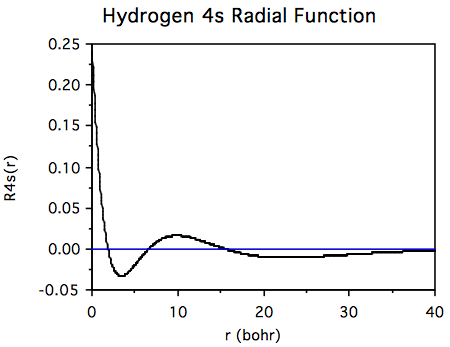
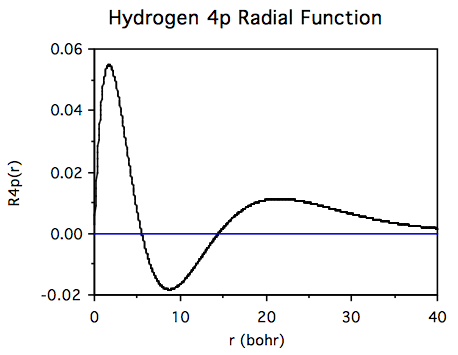


-


